
Using choice architecture to change behaviour
One of the most successful approaches to helping people act on their intentions is to carefully design the choice architecture

Image: Jonathan Ball for TEDxToronto
It would be impossible to inventory all of the useful transactions people conduct on the Internet every single day. In 2014 alone, e-retailers based in the United States sold more than $300 billion of merchandise, according to the U.S. Department of Commerce. But valuable online activity includes much more than shopping. Most U.S. colleges and universities offer online courses; and people commonly publish books, raise money for deserving charities, and even find life partners online.
Governments, however, are not always as successful at convincing citizens to access public services online. In Ontario, the provincial government has made more than 40 services available online, including address changes, driver’s license and health card renewals, and copy requests for various records such as birth and marriage certificates. Expanding citizens’ use of just one online service—the annual or biennial renewal of automobile license plates—could potentially save millions of dollars.
Since 2010, Ontarians have been able to go online to renew the stickers that display when their license plate fees expire. But as of 2013, only 10 per cent of these transactions were conducted digitally. Servicing the remaining 90 per cent of renewals in-person cost over $35 million that year. Efforts to address such discrepancies can benefit from insights produced by researchers in the field of behavioural science, who have expertise in developing and testing methods that help people accomplish behavioural change. Beginning in 2013, my colleagues and I applied our expertise in a first-of-its-kind collaboration between Ontario’s Behavioural Insights Unit (BIU) and (BEAR), the Behavioural Economics in Action centre at the Rotman School of Management. The results were promising: not only did we increase online license plate sticker renewals in Ontario, but there is also evidence that our interventions increased the number of on-time renewals. These findings suggest that no-cost interventions such as those we tested can save money and help citizens in ways beyond providing convenience. By renewing their stickers on time, vehicle owners avoid incurring citations and fines. At the same time, police forces potentially gain time to focus on more pressing enforcement matters.
Generally speaking, when it comes to acting on their good intentions, people frequently face major challenges. Behavioural scientists call this the last-mile problem. People who plan to save often put away less money than they need later, for example; and people who fully believe in the importance of a good cause end up not donating to that cause. As a result, to help people act on their good intentions, governments are increasingly applying behavioral science insights.
One of the most successful approaches to helping people act on their intentions is to carefully design the choice architecture-–that is, the way in which options are presented or preferences are elicited—in ways that ‘nudge’ people to make desirable decisions while preserving their freedom of choice. For example, people tend to view outcomes in terms of losses and gains relative to context-dependent reference points, such as when they compare an existing investment portfolio’s worth with its maximum and minimum potential value. What is more, people are about twice as sensitive to differences framed as losses compared with the same differences framed as gains, a phenomenon known as loss aversion.
Partially due to loss aversion, the default option among a group of options tends to be ‘sticky’. That is, people are reluctant to give up a default because the losses inherent in doing so often (subjectively) outweigh the relative gains of alternative options. Accordingly, defaults have been shown to exert a strong influence on choices—even those as consequential as whether to become an organ donor or whether to enroll in a 401(k) retirement savings plan.
Choice architecture interventions make use of such insights to help people make better decisions. For instance, informing people that ‘the majority of citizens pay their taxes on time’ (i.e. communicating a descriptive social norm) led to a 15 per cent increase in the percentage of British citizens who paid their overdue taxes in 2011 and 2012. During a 23-day experiment involving just 100,000 taxpayers, this resulted in an additional £9 million in government revenue. It has been estimated that this intervention could bring in approximately £160 million at very low cost when implemented countrywide.
In another field experiment, 6,824 insurance policy holders in the U.S. were asked to endorse the statement, “I promise that the information I am providing is true” with their signature at the top rather than at the bottom of an audit form before self-reporting their cars’ odometer mileage. This pre-commitment to truthfulness (acting as moral reminder) significantly reduced the extent of dishonest self-reports—resulting in an estimated additional $1 million in insurance premium revenue over a 24-month period.
Even subtle cues in a physical choice environment, such as queue guides and area carpets, can create the feeling that it is almost one’s turn and therefore increase the likelihood that consumers will stay in line rather than leave the queue.
In our own field experiment, we attempted to nudge more citizens of Ontario to renew their license plate stickers online rather than doing so in-person at Service Ontario centers. These stickers need to be attached to vehicle license plates to show that owners have paid the required fees. Vehicle owners can choose to renew for one or two years, with no discount for renewing for two. The fees for renewing online are the same as those people pay when renewing in-person.
Using insights from two areas of behavioral science research, we tested three interventions. One body of work demonstrates the importance of salience—the degree to which something grabs a person’s attention; while the other focuses on effects from framing situations or messages in terms that acknowledge losses versus gains.
The goal of our first intervention was to increase the salience of information regarding the online renewal option that citizens saw in the subject line on the mailing envelope carrying the sticker renewal form (see Figure One). Motivated by the knowledge that when some information is emphasized more than other information in a communication, the emphasized content will have greater impact on people’s judgments, we made two adjustments.
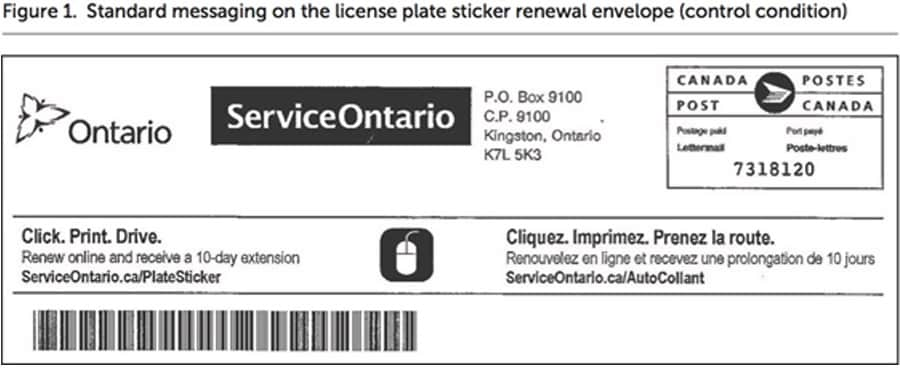
First, we embedded the black text of the subject line in a blue background to make it stand out on the exterior of an otherwise standard black-and-white pressure-sealed envelope. Second, to increase the salience of benefits from online renewal, in the subject line on the envelope, we used the wording “Instant and easy renewal online” rather than “Renew online and receive a 10-day extension.” Our reasoning was that not all consumers require a 10-day extension. Further, because renewing license plate stickers online might seem complex and daunting to people inexperienced with the procedure, focusing on its benefits could help ease people into trying an unfamiliar process (see Figure Two).
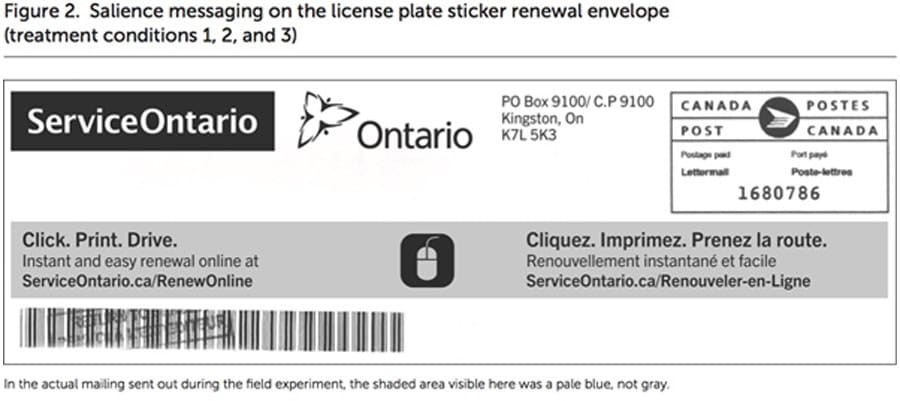
Research has shown that when people think about an immediate action, they often primarily focus on hassles or the mental effort required to perform the action, instead of the benefits. For example, when deciding whether to adopt a new technology such as a smart watch, consumers are often predisposed to think first about the learning costs (time, for instance) associated with new tools. Because of a well-documented process known as output interference, this can inhibit the consideration of potential benefits. In other words, the consideration of unwelcome factors interferes with the effective consideration of any subsequent factors.
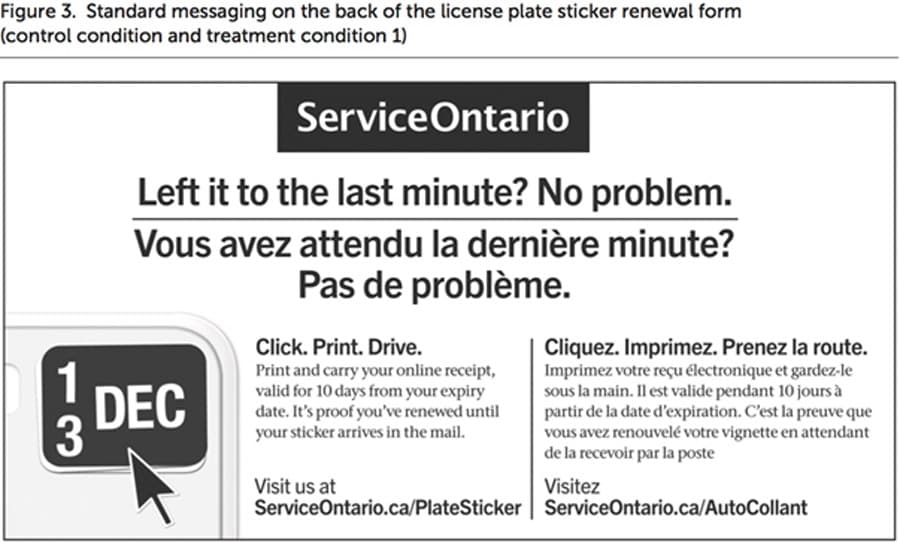
In light of these insights, we also changed the original messaging (see Figure Three) about the online renewal option printed on the back of the renewal form found inside the pressure-sealed envelope. Specifically, we designed our second and third interventions to emphasize the consumer benefits in more detail. Our goal was to prompt consideration of the benefits before a person had time to think about any hassles or costs associated with undertaking an unfamiliar process.
We framed the benefits of renewing online in two ways. In our second intervention, we directed people’s attention to the gains or positives associated with the online renewal (see Figure Four). In our third intervention, we applied one of the most robust findings in the behavioural science literature: that people are more averse to potential losses than they are attracted to equivalent potential gains. Here we highlighted the negatives, particularly the time cost, of not choosing to renew online (see Figure Five). In addition, in both of these framing interventions on the back of the form, we also used colour to try to heighten the salience of parts of the gain and loss messages by printing some text in red instead of black. The colors used in our interventions are visible in our Supplemental Material published online.
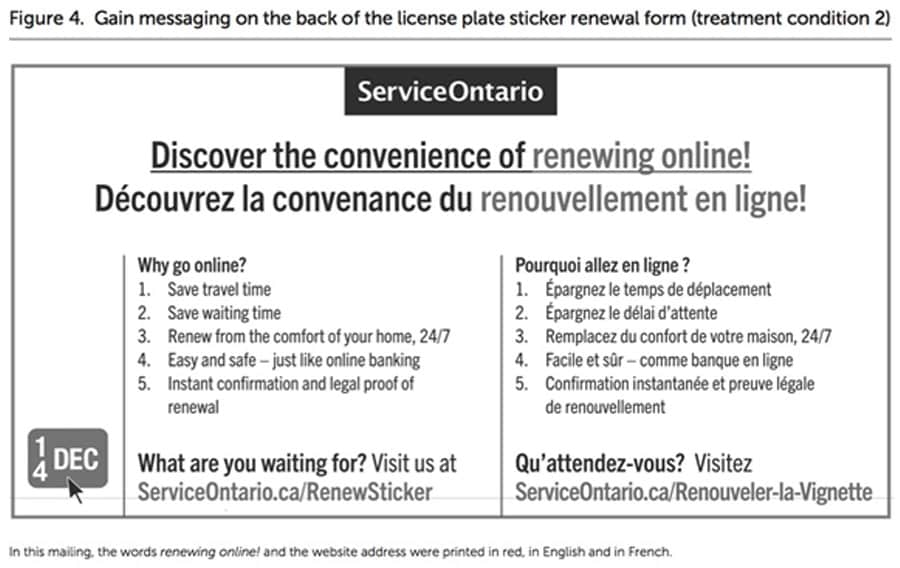
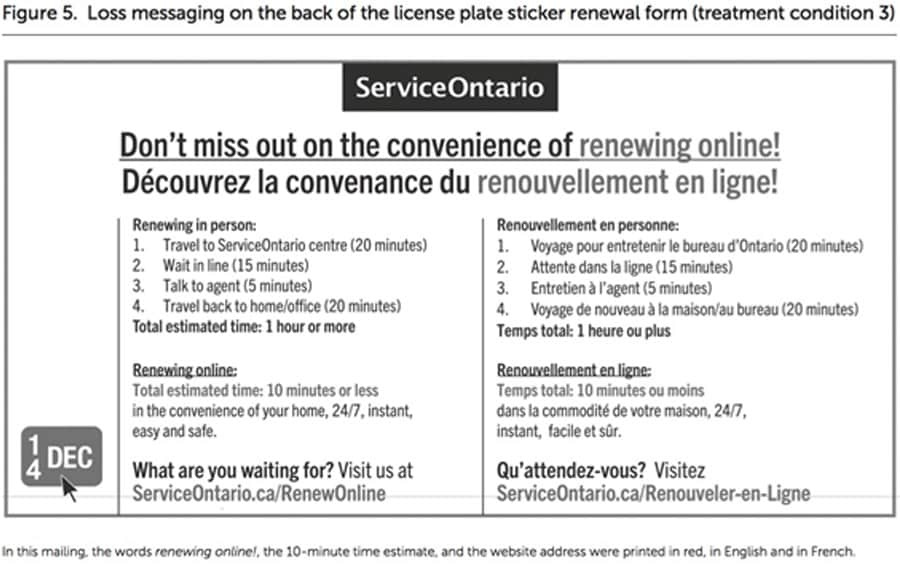
Testing Our Interventions
In our study, 626,212 owners of registered vehicles in Ontario received one of four different versions of a sticker renewal letter over eight weeks, from December 2013 to February 2014. In the control condition, owners received the provincial government’s standard renewal letter (see Figures One and Three). The rest received envelopes with the colour and text modifications described above (see Figure Two), as well as one of three different messages inside.
What we call the salience-only condition (with the envelope altered, but nothing else) featured the same message inside the envelope as the existing, standard renewal letter (see Figure Three). The salience-gain condition featured the gain-frame messaging and color modifications inside the envelope emphasizing the gains of renewing online (see Figure Four). And the salience-loss condition featured the loss-frame messaging and color modifications inside the envelope stressing the cost of not renewing online (see Figure Five).
We altered which version of the renewal letter was mailed to vehicle owners each week. Ninety days before each vehicle owner’s date of birth—when license plate stickers expire—ServiceOntario mails out renewal forms. As a consequence, vehicle owners’ assignment to one of our four conditions depended on their license plate sticker expiration date. Although complete randomization of assignment to condition would have been ideal, system limitations involved with printing and tracking hundreds of thousands of renewal forms mandated this approach.
Each condition was run two times for one-week periods, with four weeks between the periods. Our primary measure of success was the percentage of vehicle owners who renewed online. We also measured the percentage of vehicle owners in our sample who renewed on time. As can be seen in Figure Six, each of our three treatment conditions increased online renewals in comparison to the standard letter. The salience-gain treatment condition achieved the largest relative increase of 42.7% (increasing from 10.3% to 14.7%).
The increased use of the online renewal service during our eight-week experimental period saved the government approximately $28,000 in transaction fees by reducing the number of in-person transactions in Service Ontario centers, which are paid according to the number of in-person transactions processed. This estimate also takes into account marginal costs for the online service associated with meeting an increase in demand of this magnitude. We project that if the best-performing salience-gain treatment condition is adopted permanently, approximately $612,000 would be saved annually, and this gain would be achieved at virtually zero cost to the government.
Our results add to the growing number of demonstrations of how simple and often cost-free interventions rooted in behavioral science research can be applied to help people make better decisions, without resorting to financial incentives or restricting freedom of choice.
Key Takeaways
Through this study, we learned several practical lessons that may be of use to others working to apply behavioural science insights to their work:
• A behavioural insights–driven philosophy can help an organization better understand the people it serves.
• Outcomes that benefit people can lead to better outcomes for organizations.
• A thorough application of behavioural insights with RCTs requires a research team with strong policy and program knowledge, an understanding of government, and support from academics with both theoretical and experimental expertise.
• Researchers need allies to explore the promise of behavioral insights to improve policy. Organized outreach, education, and support from senior leadership, and early adopters are all needed.
This project has served to strengthen our confidence that applying behavioural principles can produce measurable and positive outcomes at a low cost.
Nina Mažar is an Associate Professor of Marketing and Co-Director of BEAR at the Rotman School of Management. Named one of the 40 Most Outstanding B-School Profs Under 40 In The World by Poets & Quants, she is on leave in 2015-16 to serve as the Senior Behavioural Scientist of the World Bank’s Global INsights Initiative (GINI) in Washington, DC. This article is adapted from her paper, written with Rotman professors Claire Tsai and Min Zhao, and Noah Castelo, Elizabeth Hardy and Julian House, and published in Behavioural Science and Policy (2015, Volume 1, Issue 2). This research was supported by a TD Bank Group Research Fund awarded to BEAR.
[This article has been reprinted, with permission, from Rotman Management, the magazine of the University of Toronto's Rotman School of Management]
X














